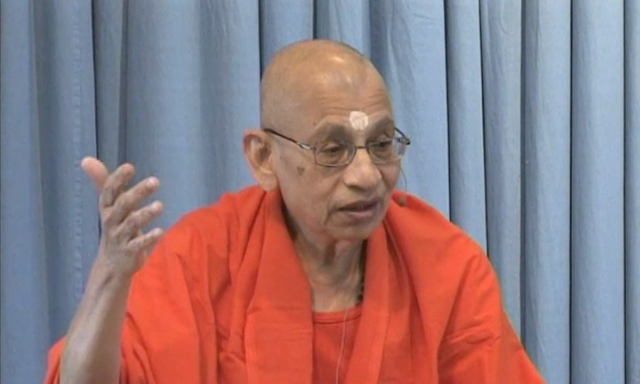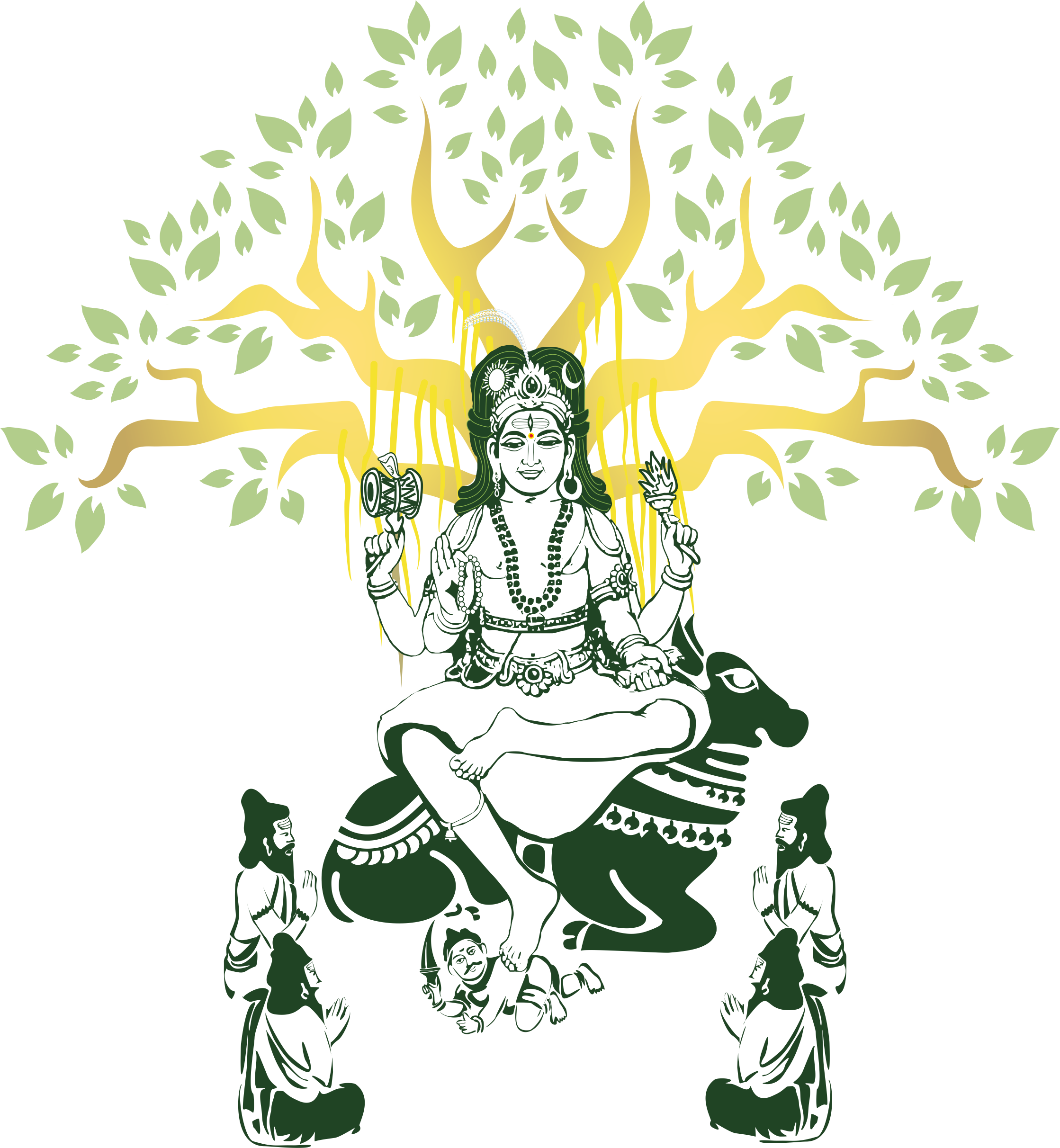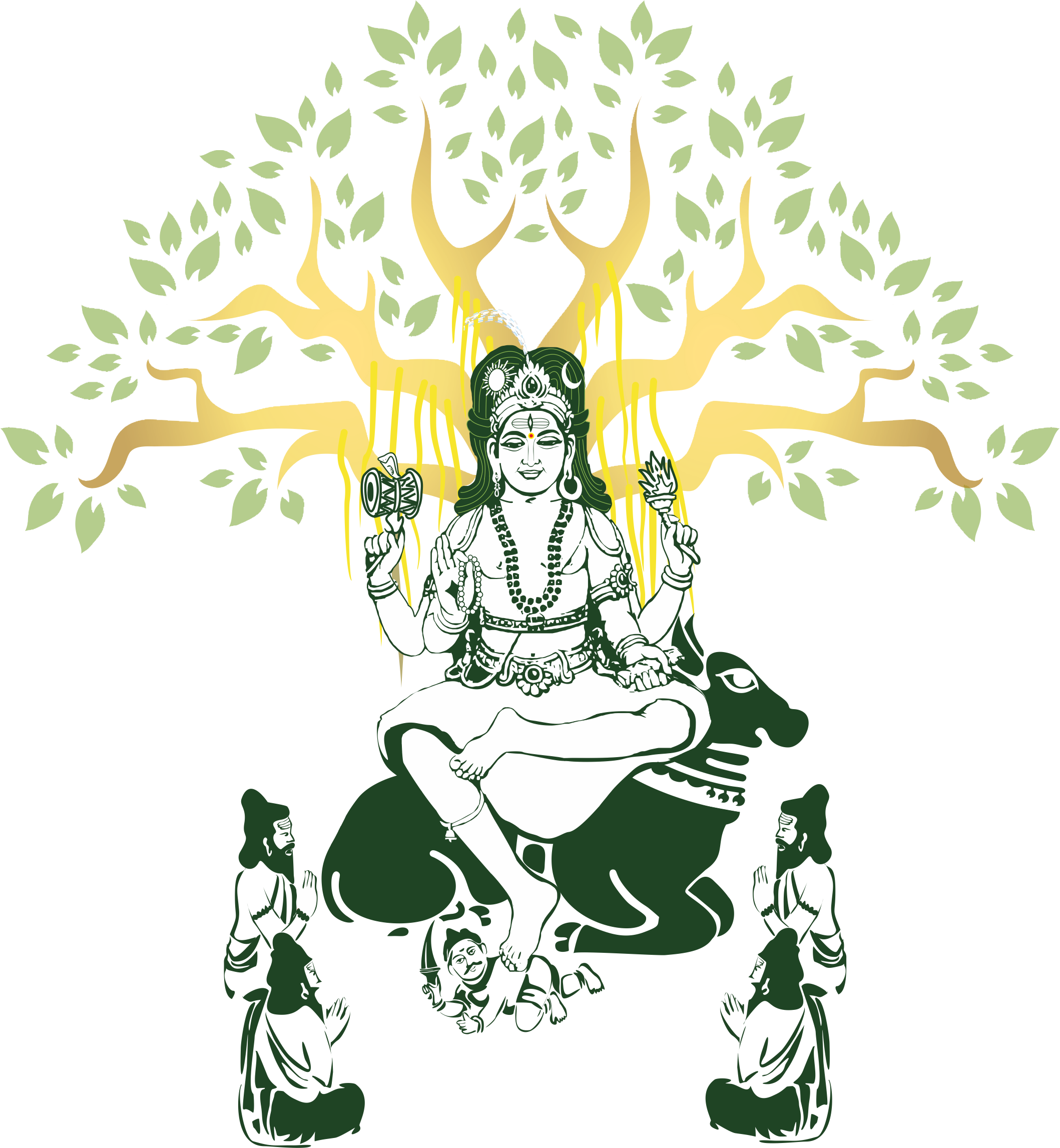Pratah Smaranam (Part-1)

The meditator and the object of meditation are different from each other in one type of meditation.
Prātaḥ is dawn and smaraṇam is remembrance or meditation. Prātassmaraṇam is thus, meditation at dawn. The meditation is upon the Self, the very meditator. Usually, meditation involves a division of meditator and that upon which he or she meditates. We meditate upon or concentrate on a form, a name, or some object or thing other than ourselves. If it is a worshipful meditation, a meditation on something reverential, we call it mental worship or upāsana. Thus, one type of meditation is of the nature of worship or upāsana. In such meditation, the meditator and the object of meditation are different from each other. This is quite valid as a kind of meditation and is a step in the right direction. Such meditation, of the nature of worship, is meant to prepare our minds. When we worship the Lord, we gain His grace or favor, which removes the impurities of our minds. While we attain the purification of the mind, we can also develop focus, the single pointedness or concentration of the mind.
Mental worship or meditation requires us to be free of the impurities of likes and dislikes
What is meant by purification of the mind? It implies that the mind becomes free from the impurities of likes and dislikes. It is these likes and dislikes, which give rise to such impulses as anger, jealousy, and greed. Whenever such impulses arise in the mind, it gets disturbed. It is our common experience that when we are jealous, hurt, or angry, the mind gets disturbed and at that time, we do not have the capacity to focus on anything. Therefore, in order to focus our minds and meditate, we need to be free from these impulses. Even meditation that involves worship or focusing on the chosen deity, the iṣṭa devatā, calls for a mind that enjoys purity and concentration.
Karma-yoga helps us get rid of the impurities of likes and dislikes
The first stage in meditation is karma-yoga, the worship of the Lord through our actions. When I perform an action, my mind and limbs are both involved. I do not require total concentration of the mind to perform an action. Therefore, it is relatively easy and the mind has the scope to wander about. To a large extent, we get rid of our impulses and likes and dislikes through karma yoga. It also prepares us for the second stage of worship, which is at the level of the mind.
Mental worship enables us to focus totally on the Self
The second stage of worship is upāsana, mental worship, which is commonly known as meditation. In upāsana, the mind has less scope for wandering and, therefore, it is relatively more difficult. Mental worship requires the purification and focus of the mind, and such worship makes the mind very refined. Over time, the mind becomes so refined that we are able to let go of everything;
we gain the capacity to withdraw the mind from all external preoccupations so that it can be to- tally focused upon the Self. This is the final stage of meditation, the meditation upon the Self, in which the mind has no room for any movement at all. This is the highest form of meditation. In Vedanta, this is called nididhyāsanam.
Listening to Vedanta is a deliberation upon the Self
Sage Yājïavalkya tells his wife Maitreyī that the Self must be seen and realized or intimately known.
ätmä vä are draṣṭavyaḥ, śrotavyaḥ, mantavya, nididhyāsitavyaḥ.
The Self is to be ‘seen’, heard of, reflected on, and meditated upon
[Bāhadāraṇyakopaniṣad, 2-4-5].
How do I know the Self? You should hear about the Self, śrotavyaḥ, meaning that you should listen to the scriptures unfolded by the teacher. The subject matter of the scriptures or Vedanta is the Self. Therefore, listening to Vedanta is nothing but a deliberation upon the Self.
Mantavyaḥ, in order to gain clarity, deliberate upon what you have heard. Often, when we listen to the teacher, the subject matter seems quite clear. However, when the influence of the teacher goes away, many doubts arise in our minds, especially on account of influences from the outside. It then becomes necessary to resolve all these doubts. Therefore, reasoning and reflecting upon what we have studied from the teacher will remove our doubts. Thus, śravanam or listening to the teacher is to be followed by mananam, reflecting upon what we have listened to, in order to remove all the doubts. As a result of śravanam and mananam, the knowledge or our understanding of it becomes clear.Subsequently, there is nididhyāsanam to remove habitual error.
Nididhyāsanam is the process of owning up to the knowledge of the Self
When we listen to the teacher, we learn that cidānanda rüpa. śivoham, I am Consciousness, Whole or Complete. Śivoham, I am Śivaḥ, auspicious. The teacher tells me that I am of the nature of knowledge and I understand it. Through mananam, this knowledge becomes free of doubts. However, my mind falls back into the same old pattern of taking this body to be myself; I habitually identify with my body, mind, and intellect. This identification has been going on from time beginningless. Even though I know I am Siva, I still identify with my body-mind complex; then, the ‘I’, as though becomes a jīva. Thus, Śiva becomes jīva and therefore, my knowledge is not beneficial to me. It is not enough to know that I am Śivaḥ; I should also live as Śivaḥ. Only then can I maintain the distance between the Self and the non-Self. The body is not my Self; I am not the body; I am not the sense organs; I am not the mind, and I am not the intellect. I am the witness; I am the Śivaḥ; I am brahman, and I am the limitless. The separation between the Self and the non-Self is created during śravanam and mananam. Only when the knowledge of this separation becomes real in our day-to-day living does it become beneficial to us.
This process of owning up to the knowledge is nididhyāsanam.
To illustrate nididhyāsanam, we normally tell the story of a beggar who turned into a multi-millionaire upon winning a lottery. He acquired everything, a big mansion, a big car etc., but the transformation from beggar to wealthy person did not take place in his mind. He continued to go back to the old habit of picking things up from the sidewalk or stretching out his hand when food was being distributed for free etc. This is habitual behavior. Another illustration is that of a newly married woman in her in-laws’ home where everything is done differently from her parents’ home. The customs are different and the way food is cooked is different. It takes time for her to blend into her new family; she forgets this again and again, and often reverts to doing things the way she is used to doing them. This is habitual error or mechanicalness.
Nididhyäsanam brings about alertness
We do many things mechanically, without much deliberate thinking. Habitually, we have been taking this body-mind complex to be ourselves. In spite of knowing that I am brahman, I as though become a jīva because of the old habit and the knowledge that I am śiva is not available to me at that time. For example, I often decide that I am not going to get angry and that I am going to be kind. However, anger sometimes takes over and I forget my resolve. Afterwards, I reflect that I should not have said this or done that, but I realize that at the time of anger, I was not alert and there- fore, my old habits took hold of me. The third stage, nididhyāsanam, is a kind of meditation where there is alertness about my true nature. That is the meditation upon the Self, the meditation upon the meditator.
Prataḥ Smaraëam reveals the nature of the Self and is ideal for nididhyāsanam
The three verses of Prataḥ Smaraṇam are of the nature of the third kind of meditation, which is upon the Self. They are very beautiful verses in which the essence of Vedanta is contained. It is the glory of Śrī Śaṅkrācārya that he can write as many as a thousand verses to teach all of Vedanta as in the Upadeśa Sähasrī or 581 verses as in the Vivekachudamani or a mere three verses as in this stotra, or even a single verse as in the Ekaślokī, and still reveal the essence of Vedanta.
We need leisure to contemplate upon these three verses. In the Vivekacüdamani [32], Śrī Śaṅkrācārya defines Vedantic bhakti or devotion as the continuous contemplation of the truth of one’s ātmā, svātmatattvānusandhānam bhaktirityapare jaguḥ. Anusandhānam is meditation upon svasvarüpa, one’s own true nature, and is the highest form of devotion. These three verses enable us to deliberate upon our true selves.
We constantly play different roles throughout the day
In guided meditation, we typically say that it is necessary to set aside some time to deliberate upon oneself because in our day-to-day living we are not true to our nature. In fact, we live differently than what we are. We put on some costume or the other all the time: that of a wife, a parent, a physician etc., and we keep changing the different costumes we wear.
Every situation requires that we respond to it in an appropriate manner. Thus, every situation invokes a different kind of self from me: sometimes it is the parent, sometimes it is the spouse, sometimes it is the child, and at some other times, the friend. Thus, I play a variety of roles throughout the day. We have to relate to the world and each relationship requires an appropriate response from me. Thus, in the presence of my father, the son in me is invoked. That is the only appropriate way to relate to my father. In the presence of my son, however, I become the father. In the presence of my teacher, I am an obedient, devoted disciple, and when I am required to teach, I am a guru. Thus, every situation requires me to behave in an appropriate manner and invoke the appropriate self. I am like an actor putting on different costumes, e.g., that of a king, beggar, or minister. These are but different costumes. I do know myself as a person related to somebody or something. But who am I when I am not related? Who am I out of all these costumes? Who is the one playing these roles?
Who am I?
Naturally, the one who is playing the role is different from the roles. When the same actor can become king, beggar, or minister, it is very clear that he is not any one of those. He is different from all of the roles. He is in all of them and yet, different from all of them. Similarly, I can be a father, son, or brother provided I am different from all of those roles. I need to know who I am when all the costumes are removed. It is not enough to know ourselves as we do now, as the relative person. It is necessary to know who I am when I am not related to anything. Who is the invariable absolute person? Who is the one in every costume, yet different from each? Who is he? It is necessary to know the Self of all these roles. Why should I know my true Self? What do I get out of it? All these years have gone by quite satisfactorily without my knowing this Self; in functioning as a physician or attorney, it is not necessary to know who I am. It is perhaps alright for a renunciate to know the Self, but what is the use of this knowledge for people like us who are involved in day-to- day life? Does this knowledge of the nature of my Self have any relevance to the life I am leading now?
Knowledge of the Self enables us to not be affected by the problems of the roles
Yes, this knowledge of the Self does have a tremendous relevance in day-to- day life. It is the most relevant thing to everyone, whether renunciate or householder. If I know the relative self as being the relative self, it is fine. However, the relative self is taken to be the true Self. For example, it is well as long as an actor, who is playing the role of beggar, remembers that he is playing the role of beggar. But then, if he identifies with the role to the extent that he behaves like one, the fact that he is a multi-millionaire is of no use to him because he takes himself to be a beggar. Only when he is aware that he is only playing the role of a beggar will he be aware of his true identity! Isn’t it so? It is only when the actor is aware of his true identity that all the problems that belong to the beggar will remain at the level of the role and not affect him. As a beggar, he will be insulted, slapped, or favored; these are features of the role. When someone insults him, tears flow out of his eyes. Yet, he knows that the problems of the role do not touch him. Thus, in spite of doing what is to be done, he enjoys his freedom and is able to perform his role effectively. If he identifies with the role, however, he cannot perform his role effectively. Similarly, we should also recognize that all of our transactions are carried out by the relative person.
It is necessary that we should know the true identity of the person who is playing these roles. When one knows the true identity, the roles remain roles and what happens at the level of the roles does not affect us. Otherwise, we are not playing a role, but become the role itself. That is what is happening to us right now in our roles; there is no distance between the person and the roles. That is why there is sorrow and suffering or hurt and guilt in our lives. If we could maintain a distance and assert our independence, everything would become a play. You can enjoy even an insult. Even while the actor is crying in his role as a beggar, he is pleased that he is crying well. He can enjoy the crying because it is not real; his begging is not true begging because of the distance he maintains between himself and the role. In fact, the actor knows that his acting is going to earn him a few millions!
Self-knowledge is absolutely necessary for everybody. There is a false notion that this knowledge is for sannyāsis or retired people. It is wonderful to have this knowledge anytime in life. The ability to create a distance between the actor and the role enables us to live our lives more fully. Who is this actor? It is to know this that I meditate at dawn. I can let go of all my costumes and roles and look at myself as I am, apart from my roles, and see the beauty of my own self. It is not always beneficial to see the realities because the realities can also be unpleasant. Fortunately, however, the reality of the Self is so wonderful that it is most satisfying and fulfilling to see ourselves for what we are.
Meditation is most beneficial to us early in the morning
Why do I meditate upon myself at dawn? It is then that my mind is well rested after a full night’s sleep and is sāttvik. The mind is sāttvik when it is quiet, tranquil, and contemplative. As the sun rises, the mind becomes more active and is then rājasik. The sun represents rajas, activity. When the sun sets, tamas comes with the darkness. We don’t want tamas or rajas. We want to be awake, yet quiet. We want a mind that is quiet, but not sleepy. Early in the morning, the mind is fresh. None of the problems and the situations of the day have taken hold of it and therefore, this is the time of the day when the meditation is most beneficial to us.
Transcribed by Richa Choudhry and edited by Krishnakumar (KK) S. Davey and Jayshree Ramakrishnan.



